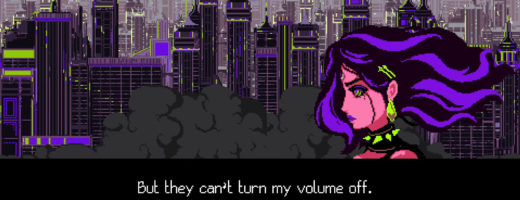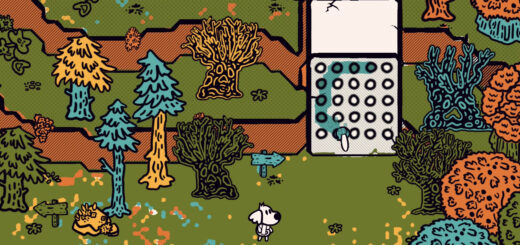Mable & The Wood Review
I Swear I Was Pressing the Button!!
From the moment players pick up the controller to play Mable & The Wood, they’re in for a very unusual experience. That’s because this short two-dimensional side-scrolling RPG features an unorthodox control scheme and gameplay style. It’s so different that describing it as a platformer is barely adequate. Unfortunately, despite the unique design ideas it brings to the table, it falls flat in the execution of those ideas.
Mable & The Wood begins with players taking control of Mable, a girl who has been summoned by a cult and can transform into a fairy. Mable is told to fulfill a prophecy to save the world by defeating powerful beasts and taking their forms. Players learn a bit more about the world and Mable herself along the way, but the delivery and discovery of the lore is woefully lacking and easy to both miss and ignore. Indeed, on the surface, there’s not much more to the story than this. There is a question, however, over whether the prophecy is the right path to save the world, and it appears that maybe there’s more than meets the eye here. In theory it is possible to avoid killing any enemies including bosses, and doing so reveals another ending, but in any case the core of the story is minimal and doesn’t have much of an impact except a twist here and there.
The game is hard to navigate as there is no map to rely on in in most areas. Even for areas that do have one, players can only see a static map, but not their location on it — though landmarks can help them get a fix on their location. The difficulty in navigation is a double-edged sword, offering exploration that is more mysterious but making backtracking a chore. Speaking of backtracking, the game is split into several acts, and while players can backtrack to areas within an act, paths to previous acts become blocked. Exploration is also rarely rewarded since the game lacks any sort of item system, with only health and energy upgrades to find.
From a gameplay perspective, there’s a lot to digest. Mable drags a large sword around but cannot swing it. Instead, she can leave it in the ground, transform into a fairy to fly around enemies, and then pull the sword to her to damage them. Over the course of the game, she learns to transform into other forms, each with unique controls, movement styles, and limitations, giving her new attacks and the ability to overcome previously insurmountable obstacles. There’s an energy bar that very quickly depletes when Mable is using her abilities, but also instantly replenishes itself when she is not and is touching solid ground.
The mechanic of changing between forms to tackle challenges and puzzles, combined with the unique controls, could have lead to very interesting gameplay. Instead, the controls are sloppy and imprecise, marred with technical bugs and issues, and overall very difficult to use. These problems are exacerbated tenfold as the game seems designed with poor controls as the intention. Most of the challenge comes from getting knocked into one-hit-kill pit traps that pervade all areas due to a combination of imprecise and buggy controls, Mable’s tendency to get knocked around like a pinball when getting hit by enemies, and the quickly depleting energy that is keeping her afloat above said traps. When Mable takes damage she drops some of her crystals, a form of currency, and has to pick them up again. If she dies, she leaves behind a statue with all her crystals that must be retrieved. Unfortunately, this doesn’t work at all as a death penalty because there isn’t much to buy, and running into merchants is so infrequent that players will learn early on not to care about crystals.
Combat in Mable & The Wood is slow and unintuitive. As mentioned previously, the main form of attack is by dropping Mable’s sword to the ground, flying to the opposite side of enemies so they are between her and her sword, and then pulling the sword back. While an interesting and sometimes fun mechanic, most of the time this process is slow, as the player must wait for enemies to get into the correct place before being able to attack. The developers seem to be aware of this as Mable & The Wood is much more sparsely populated with enemies than other games. The slow and unintitive combat also constrains boss designs and is reflected in the simplicity of boss encounters.
Mable & The Wood features a dark and moody aesthetic that is consistent throughout its different environments, which range from snowy mountains, to dark sewers, to lush forests. Despite the cohesive and immersive aesthetic, the quality of the areas varies greatly. On the one hand, some backgrounds are detailed and use numerous parallax layers and feature lighting and reflection effects. On the other, others are flat and almost uniformly colored. The disparity in quality leaves some areas feeling unfinished while others serve as contrasting examples of what could have been. Sprites also leave a lot to be desired, often being small, lacking detail, and either being static or having slow and clunky animations.
Despite its other shortcomings, the soundtrack in Mable & The Wood is very strong and features a plethora of great moody melodies. While the simplicity of the tracks and the lack of variety in consistently dark themes do somewhat hold the soundtrack back, it is nevertheless enjoyable to listen to. Each track feels markedly different from the rest despite the thematic similarities, with many memorable tracks that work well to set apart the different game areas in players’ minds. Sound effects can be rough or missing, and there is no voice acting to speak of, though given the few lines of dialogue it isn’t particularly necessary.
If there’s one word to describe Mable & The Wood, that word is “unfinished”. The game feels like an alpha version, not a version anywhere near ready for release. There are many unique mechanics introduced here that have a lot of potential, but between the lack of interesting ways in which said mechanics are used and the terrible controls, they only work to hinder the game. The game is also one of the buggiest games I’ve played; its litany of bugs range from falling through walls, to abilities that don’t work correctly or unintentionally trivialize encounters and obstacles, and even bugs of the game-breaking kind. This is a game with great ideas but horrid execution, both from a technical and a design perspective, and it’s really a shame. Here’s hoping the developers will take what’s good here and execute better on it in the future.


Unique game mechanics
Moody atmosphere with some great areas and backgrounds
Excellent, if limited, soundtrack
Some areas don't feel visually complete
Poor use of game mechanics
Terrible controls
Bugs galore
Story wastes its strong premise and handful of interesting twists













Recent Comments